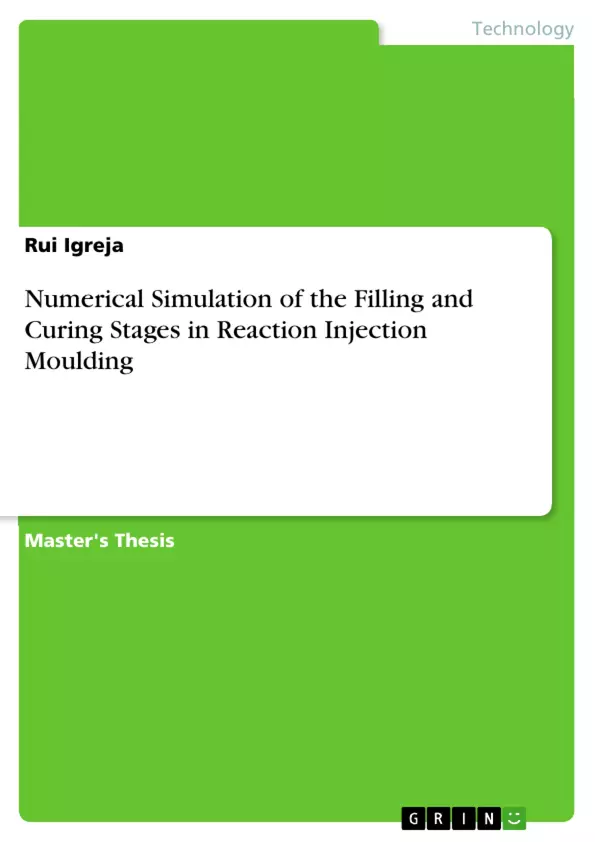
Numerical Simulation of the Filling and Curing Stages in Reaction Injection Moulding
Masterarbeit, 2007
120 Seiten
Leseprobe
Frequently asked questions
What is the main topic of this document?
The document focuses on the numerical simulation of the filling and curing stages in Reaction Injection Moulding (RIM), using CFX (now ANSYS CFX) software. It includes analyses of the filling process using both homogeneous and inhomogeneous models, simulation of the curing process, and a combined simulation of filling and curing.
What is Reaction Injection Moulding (RIM)?
RIM is a process for rapid production of complex parts through the mixing and chemical reaction of two or more components, typically isocyanate and polyol. The liquid components are injected into a mixing chamber and then flow into a mold cavity where they polymerize and cure.
What are the key differences between Thermoplastics Injection Moulding (TIM) and Reaction Injection Moulding (RIM)?
TIM involves injecting hot polymer melt into a cold cavity where it solidifies by cooling. RIM involves injecting liquid components into a mold where they undergo chemical reaction (curing) to form a solid part. TIM uses thermoplastics, which can be re-melted, while RIM uses thermosets, which undergo an irreversible chemical reaction.
What is the homogeneous model used for in the document?
The homogeneous model assumes that both phases (resin and air) in the filling process share a single velocity field. It's typically used for modeling free surface flows where phases are completely stratified.
What are the limitations of using the homogeneous model for RIM simulation, according to the document?
The document finds that the homogeneous model, with the usual no-slip boundary condition, is unable to model the filling process correctly, leading to an incorrect interface that doesn't touch the walls.
What is the inhomogeneous model and how does it address the limitations of the homogeneous model?
The inhomogeneous model uses separate flow fields for each phase (resin and air) and accounts for interphase momentum transfer. It overcomes the limitations of the homogeneous model by implementing a free-slip boundary condition for the air phase at the walls, allowing for a more accurate representation of the filling process.
How is the cure reaction implemented in the numerical simulations?
The cure reaction is implemented as a transport equation for an additional scalar variable representing the degree of cure, with a source term representing the rate of cure. Various transient and advection schemes are tested for accuracy.
What are the key findings related to the energy equation in the context of RIM simulation?
The viscous dissipation term can often be neglected compared to the heat generated by the cure reaction. A high temperature gradient can be observed on the mould walls when the flow front arrives.
What is the significance of the Courant number (Cr) in the simulations?
The Courant number is related to numerical stability. The advection scheme chosen for the volume fraction equation automatically allows high Courant numbers locally with boundedness principles to keep the interface sharp.
What are the key software and numerical methods used in this work?
The simulations are performed using the commercial CFD software package ANSYS CFX. Numerical methods include the finite volume method (FVM), different transient and advection schemes, and various two-phase flow models.
What are key themes explored in this document based on the table of contents?
Key themes explore the filling process in the RIM, including using the homogenous and inhomogenous model. There is a key focus on the curing process and simulation of the RIM filling and curing stages.
Details
- Titel
- Numerical Simulation of the Filling and Curing Stages in Reaction Injection Moulding
- Autor
- Rui Igreja (Autor:in)
- Erscheinungsjahr
- 2007
- Seiten
- 120
- Katalognummer
- V273166
- ISBN (Buch)
- 9783656649243
- ISBN (eBook)
- 9783656649250
- Dateigröße
- 3320 KB
- Sprache
- Englisch
- Anmerkungen
- Schlagworte
- Mould Filling Numerical Simulation Two-Phase Flow ANSYS CFX CFD RIM ANSYS CFX Reaction Injection Moulding
- Produktsicherheit
- GRIN Publishing GmbH
- Preis (Ebook)
- US$ 0,99
- Preis (Book)
- US$ 49,99
- Arbeit zitieren
- Rui Igreja (Autor:in), 2007, Numerical Simulation of the Filling and Curing Stages in Reaction Injection Moulding, München, Page::Imprint:: GRINVerlagOHG, https://www.diplomarbeiten24.de/document/273166
- Autor werden
- Ihre Optionen
- Vertriebskanäle
- Premium Services
- Autorenprofil
- Textarten und Formate
- Services für Verlage, Hochschulen, Unternehmen

- © GRIN Publishing GmbH.
- Alle Inhalte urheberrechtlich geschützt. Kopieren und verbreiten untersagt.
- info@grin.com
- AGB
- Open Publishing
Der GRIN Verlag hat sich seit 1998 auf die Veröffentlichung akademischer eBooks und Bücher spezialisiert. Der GRIN Verlag steht damit als erstes Unternehmen für User Generated Quality Content. Die Verlagsseiten GRIN.com, Hausarbeiten.de und Diplomarbeiten24 bieten für Hochschullehrer, Absolventen und Studenten die ideale Plattform, wissenschaftliche Texte wie Hausarbeiten, Referate, Bachelorarbeiten, Masterarbeiten, Diplomarbeiten, Dissertationen und wissenschaftliche Aufsätze einem breiten Publikum zu präsentieren.
Kostenfreie Veröffentlichung: Hausarbeit, Bachelorarbeit, Diplomarbeit, Dissertation, Masterarbeit, Interpretation oder Referat jetzt veröffentlichen!
- GRIN Verlag GmbH
-
- Nymphenburger Str. 86
- 80636
- Munich, Deutschland
- +49 89-550559-0
- +49 89-550559-10
- info@grin.com
-









